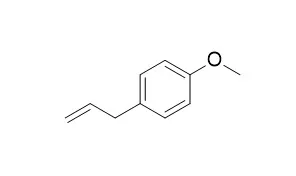| In vivo: |
| Journal of the National Cancer Institute, 1976, 57(6):1323-31. | | Hepatocarcinogenicity of estragole (1-allyl-4-methoxybenzene) and 1'-hydroxyestragole in the mouse and mutagenicity of 1'-acetoxyestragole in bacteria[Pubmed: 187802] |
METHODS AND RESULTS:
Approximately 20% of a dose of Estragole, a naturally occurring flavoring agent, was excreted in the urine of outbred male CD -1 mice
as a conjuage (presumably the glucuronide) of 1'-hydroxyEstragole, Estragole and its 1'-hydroxy metabolite caused significant increases in the incidences of hepatocellular carcinomas in male CD-1 mice that received the compounds by sc injection at 1-22 days of age. Estragole induced hepatocellular carcinomas by 15 months in 23 and 39% of the mice that received total doses of 4.4 and 5.2 mumoles, respectively, and lived to an age of 12 months or more. Of the 12-month survivors given a total dose of 4.4 mumoles of 1'-hydroxyEstragole, 70% developed hepatocellular carcinomas; the incidence in mice that received only the vehicle (trioctanoin) was 12%. Multiple tumors ocurred in 5, 28, 64, and 0%, respectively, of the mice in each of these 4 groups. Of the mice given a total dose of 4.4 mumoles of 1'-hydroxysafrole, 59developed hepatocellular carcinomas; 39% of the mice bore multiple liver tumors.
CONCLUSIONS:
As previsously demonstrated for 1'-acetoxysafrole, 1'-acetoxyEstragole and 1'-acetoxy-1-allyl-4-methoxynaphthalene reacted nonenzymatically with guanosine and inosine to form adducts. These electrophilic esters were strongly mutagenic for the Salmonella typhimurium missense mutant TA100. 1'-Acetoxyallybenzene had little or no activity in either of these tests. Attempts to demonstrate liver-mediated mutagenicty for 1'-hydroxysafrole and 1'-hydroxyEstragole in the bacterial test system were unsuccessful. | | Life ences, 2006, 78(20):2365-2372. | | Cardiovascular effects of the essential oil of Croton zehntneri leaves and its main constituents, anethole and estragole, in normotensive conscious rats.[Pubmed: 16325210] | Cardiovascular effects of the essential oil of Croton zehntneri (EOCZ) were investigated in conscious rats.
METHODS AND RESULTS:
In these preparations, intravenous (i.v.) injections of EOCZ (1-20 mg kg(-1)) and its main constituents anethole and Estragole (both at 1-10 mg kg(-1)) elicited brief and dose-dependent hypotension and bradycardia (phase I) that were followed by a significant pressor effect associated with a delayed bradycardia (phase II). The initial hypotension and bradycardia (phase I) of EOCZ were unchanged by atenolol (1.5 mg kg(-1), i.v.) or L-NAME (20 mg kg(-1), i.v.) pretreatment, but were respectively reversed into pressor and tachycardic effects by methylatropine (1 mg kg(-1), i.v.) pretreatment. The subsequent pressor effect and the delayed bradycardia (phase II) remained unaffected by atenolol, but were abolished by L-NAME and methylatropine pretreatment, respectively. In rat endothelium-containing aorta preparations, the vasoconstrictor responses to phenylephrine were enhanced and reduced, respectively, by the lower (1-30 microg mL(-1)) and higher (300-1000 microg mL(-1)) concentrations of EOCZ. Only the enhancement of phenylephrine-induced contraction was abolished by either the incubation with L-NAME (50 microM) or in the absence of the endothelium.
CONCLUSIONS:
These data show, for the first time, that i.v. administration EOCZ induces an initial hypotension followed by a pressor response, two effects that appear mainly attributed to the actions of anethole and Estragole. The EOCZ-induced hypotension (phase I) is mediated by a cholinergic mechanism and seems to result mainly from the concomitant bradycardia. The pressor response of EOCZ (phase II) seems to be caused by an indirect vasoconstrictive action of EOCZ most likely through inhibition of endothelial nitric oxide production. |
|






 Cell. 2018 Jan 11;172(1-2):249-261.e12. doi: 10.1016/j.cell.2017.12.019.IF=36.216(2019)
Cell. 2018 Jan 11;172(1-2):249-261.e12. doi: 10.1016/j.cell.2017.12.019.IF=36.216(2019) Cell Metab. 2020 Mar 3;31(3):534-548.e5. doi: 10.1016/j.cmet.2020.01.002.IF=22.415(2019)
Cell Metab. 2020 Mar 3;31(3):534-548.e5. doi: 10.1016/j.cmet.2020.01.002.IF=22.415(2019) Mol Cell. 2017 Nov 16;68(4):673-685.e6. doi: 10.1016/j.molcel.2017.10.022.IF=14.548(2019)
Mol Cell. 2017 Nov 16;68(4):673-685.e6. doi: 10.1016/j.molcel.2017.10.022.IF=14.548(2019)